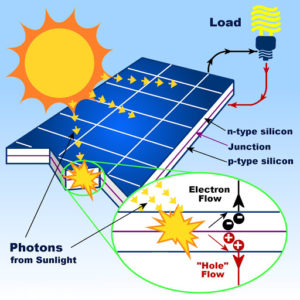What Does Photovoltaic Mean?

“Photovoltaic” seems like a very complicated scientific word but it’s actually not.
“Photo” means light and “voltaic” means volt.
So, volts produced by light.
In its simplicity, the photovoltaic effect is when material produces electricity from sunlight.
The photovoltaic effect was first discovered by a French physicist named Alexandre Edmond Becquerel in 1839 when he was only 19 years old.
While working in his father’s laboratory Alexandre generated electricity by illuminating an electrode with different types of light, including sunlight. He found that ultraviolet or “UV” light worked the best.
To better understand this let me back up just a tad.
Sunlight Contains Energy
Light travels quite a distance from the Sun to reach Earth. It does so in the form of rays.
If you were to look very closely at a ray of sunlight, and I mean VERY CLOSELY, you’d see that sunlight is actually made of a lot of different stuff.
For example, when you go to the beach you get a suntan because of the radiation contained in sunlight.
Every ray of sunlight also contains “photons.”
A photon is an elementary particle that has energy.
That’s right, sunlight carries energy!
In the photovoltaic effect, material captures, transfers, or emits those photons and turns them into electrons – a basic unit of electricity.
There are a number of basic elements that can be used to capture, transfer, or emit the photons found in sunlight.
Conductors and Semiconductors
Electricity is very fluid and can transfer from one place to another very quickly, but only if a material allows it to transfer.
In the world of electricity, there are materials that can transfer electricity from one place to another very easily (conductors), there are materials that transfer some electricity (semiconductors), and there are materials that don’t let any electricity pass, such as wood or rubber.
Metal is a great conductor. However, for the purpose of producing electricity from sunlight, metals don’t work.
If you leave a piece of metal in the sun for too long, all it does is get very hot.
However, some semiconductors are able to capture energy from the sun and emit electrons.
What Are Solar Panels Made of?
Solar panels use both conductors and semiconductors to produce electricity.
The blue or black parts of solar panels are made up of silicon, which is a semiconductor.
There are two main kinds of silicon cells used in the construction of solar panels, but both are able to capture energy from sunlight.
Each solar cell is constructed in layers of negative and positively charged layers. This “sandwich” allows electrons to flow as an electric current towards the metal that surrounds the cells.
Metal, being a great conductor, grabs the electricity and channels it into wires that are connected to the solar panel, and voila, you have electricity!
Unfortunately, the kind of electricity produced by solar panels is not the same kind of electricity that can be used by your home. To better understand how solar panels work and how they produce electricity that can be used by your home, and the power grid, please read the article I wrote on How Solar Panels Work.
Article by
Rebecca Samson
Editor, Bio Development



Recent Comments